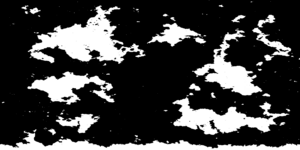Luzonta
Jump to navigation
Jump to search
This page contains the canonical information about the planet Luzonta, if you are looking for regional information look at Luzonta (Region).
 A black and white map of Luzonta. | |||||||||||||
| Designations | |||||||||||||
|---|---|---|---|---|---|---|---|---|---|---|---|---|---|
| The World | |||||||||||||
| Orbital characteristics | |||||||||||||
| Epoch A2000 | |||||||||||||
| Aphelion | 152100000 km (94500000 mi) | ||||||||||||
| Perihelion | 147095000 km (91401000 mi) | ||||||||||||
| 149598023 km (92955902 mi) | |||||||||||||
| Eccentricity | ~0.0167086 | ||||||||||||
| 365 d (12.0 months) | |||||||||||||
Average orbital speed | 29.78 km/s (18.50 mi/s) | ||||||||||||
| 358.617° | |||||||||||||
| Physical characteristics | |||||||||||||
Equatorial radius | 6378.1 km (3963.2 mi) | ||||||||||||
Polar radius | 6356.8 km (3949.9 mi) | ||||||||||||
| Flattening | 0.0033528 | ||||||||||||
| Circumference | 40075.017 km (24901.461 mi) (equatorial) 40007.86 km (24859.73 mi) (meridional) | ||||||||||||
| 510,072,000km2 (316,944,000 mi2) | |||||||||||||
| Volume | 1.08321 × 1012km3 | ||||||||||||
| Mass | 5.97237 x 1024 kg | ||||||||||||
Mean density | 5.514 g/cm3 | ||||||||||||
| 9.807 m/s2 | |||||||||||||
| 0.3307 | |||||||||||||
| 11.186 km/s (6.951 mi/s) | |||||||||||||
Sidereal rotation period | 0.99726968 d (23.934472 h) | ||||||||||||
Equatorial rotation velocity | 0.4651 km/s (0.2890 mi/s) | ||||||||||||
| 23.4392811° | |||||||||||||
| Albedo | 0.367 geometric 0.306 Bond | ||||||||||||
| |||||||||||||
| Atmosphere | |||||||||||||
Surface pressure | 101.325 kPa (at MSL) | ||||||||||||
| Composition by volume | 78.08% nitrogen (N2) (dry air) 20.95% oxygen (O2) 0.930% argon 0.039% carbon dioxide (climate-variable) | ||||||||||||
Luzonta, or the Earth (Anglish) or Tierro (Spanish) is the fourth planet from the Son. It is the only known planet to accommodate life. There are around 8 million different plant and animal species around the World. Scientific analysis has concluded that Luzonta formed andd developed over 4 billion years ago. The Earth rotates around the Son in 365 and ¼ days, a period commonly accepted as an Earth year.